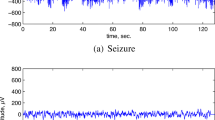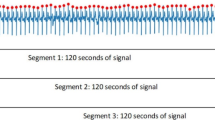Abstract
Permutation entropy (PE) was recently introduced as a very fast and robust algorithm to detect dynamic complexity changes in time series. It was also suggested as a useful screening algorithm for epileptic events in EEG data. In the present work, we tested its efficacy on scalp EEG data recorded from three epileptic patients. With a receiver operating characteristics (ROC) analysis, we evaluated the separability of amplitude distributions of PE resulting from preictal and interictal phases. Moreover, the dependency of PE on vigilance state was tested by correlation coefficients. A good separability of interictal and preictal phase was found, nevertheless PE was shown to be sensitive to changes in vigilance state. The changes of PE during the preictal phase and at seizure onset coincided with changes in vigilance state, restricting its possible use for seizure prediction on scalp EEG; this finding however suggests its possible usefulness for an automated classification of vigilance states.
Sommario
È stato recentemente introdotto un algoritmo denominato Permutation Entropy (PE) a cui gli autori Bandt e Pompe (2002) attribuiscono due caratteristiche interessanti: la robustezza e la relativa rapidità di implementazione, proprietà entrambe utili nell’individuazione delle variazioni di complessità in serie temporali. Sulla scia di un iniziale ottimismo, la PE è stata suggerita come un possibile ausilio di ricerca su dati elettroencefalografici relativi a crisi epilettiche. Un primo obiettivo del nostro studio era testare l’efficacia dell’algoritmo, su dati elettroencefalografici di scalpo, registrati da 3 pazienti epilettici. Mediante l’applicazione di una ROC (Receiver Operating Characteristics) analisi abbiamo valutato la separabilità delle distribuzioni delle ampiezze di PE, rispettivamente per la fase preictale per quella interictale, su ogni registrazione di scalpo. Il secondo obiettivo è stato quello di indagare le eventuali correlazioni sussistenti fra l’andamento della PE e gli stati di vigilanza. Troviamo una buona separabilità fra le curve di dati preictali e interictali di ciascun paziente, seppure è evidente che la PE sia sensibile al cambio di stati di vigilanza, poiché spesso l’inizio di un evento accessuale era concomitante a cambi di stati di vigilanza. Alla luce di queste osservazioni, concludiamo che al momento non è possibile valutare l’affidabilità della PE come algoritmo predittore di crisi su dati elettroencefalografici di superficie, mentre appare sicuramente più attendibile come classificatore automatico degli stati di vigilanza.
Similar content being viewed by others
References
Theodore WH, Hunter K, Chen R et al (2002) Transcranial magnetic stimulation for the treatment of seizures: a controlled study. Neurology 4:560–562
Sterman MB (2000) Basic concepts and clinical findings in the treatment of seizure disorders with EEG operant conditioning. Clin Electroencephalogr 31:45–55
Kotchoubey B, Strehl U, Uhlmann C et al (2001) Modulation of slow cortical potentials in patients with intractable epilepsy. Epilepsia 42:406–416
Iasemidis LD, Pardalos P, Sackellares JC, Shiau DS (2001) Quadratic binary programming and dynamical system approach to determine the predictability of epileptic seizures. J Comb Optimization 5:9–26
Lehnertz K, Elger CE (1998) Can epileptic seizures be predicted? Evidence from nonlinear time series analysis of brain electrical activity. Phys Rev Lett 80:5019–5022
Le Van Quyen M, Martinerie J, Navarro V et al (2001) Anticipation of epileptic seizures from standard EEG recordings. Lancet 357:183–188
Drury I, Smith B, Li D, Savit R (2003) Seizure prediction using scalp electroencephalogram. Exp Neurol 184:9–18
Li D, Zhou W, Drury I, Savit R (2006) Seizure anticipation, states of consciousness and marginal predictability in temporal lobe epilepsy. Epilepsy Res 68:9–18
Li X, Kapiris PG, Polygiannakis J et al (2005) Fractal spectral analysis of pre-epileptic seizures phase: in terms of criticality. J Neurol Eng 2:11–16
Li X, Ouyang G, Richards DA (2007) Predictability analysis of absence seizures with permutation entropy. Epilepsy Res 77:70–74
Litt B, Echauz J (2002) Prediction of epileptic seizures. Lancet Neurol 1:22–30
Osorio I, Frei MG, Giftakis J (2002) Performance reassessment of a real-time seizure-detection algorithm on long ECoG series. Epilepsia 43:1522–1535
Savit R, Li D, Zhou W, Drury I (2001) Understanding dynamic state changes in temporal lobe epilepsy. J Clin Neurophysiol 18:246–258
Protopopescu V, Hively L, Gailey P (2001) Epileptic event forewarning from scalp EEG. J Clin Neurophysiol 18:223–245
McSharry PE, He T, Smith LA, Tarassenko L (2002) Linear and non-linear methods for automatic seizure detection in scalp electroencephalogram recordings. Med Biol Eng Comput 40:447–461
Aschenbrenner-Scheibe R, Maiwald T, Winterhalder M et al (2003) How well can epileptic seizures be predicted? An evaluation of a nonlinear method. Brain 126:2616–2626
Hively LM, Protopopescu VA (2003) Channel-consistent forewarning of epileptic events from scalp—EEG. IEEE Trans Biomed Eng 50:584–593
Mormann F, Kreuz T, Rieke C et al (2005) On the predictability of epileptic seizures. Clin Neurophysiol 116:569–587
Mormann F, Andrzejak RG, Elger CE, Lehnertz K (2007) Seizure prediction: the long and winding road. Brain 130:314–333
Navarro V, Martinerie J, Le Van Quyen M et al (2005) Seizure anticipation: do mathematical measures correlate with video-EEG evaluation? Epilepsia 46:385–396
Schelter B, Winterhalder M, Dahlhaus R et al (2006) Partial phase synchronization for multivariate synchronizing systems. Phys Rev Lett 96:2081031
Bandt C, Pompe B (2002) Permutation entropy. A natural complexity measure for time series. Phys Rev Lett 88:174102
Cao Y, Tung W, Gao JB et al (2004) Detecting dynamical changes in time series using the permutation entropy. Phys Rev E 70:046217
Billiard M (1982) Epilepsy and the sleep-wake cycle. In: Sterman MB, Shouse MN, Passounant P (eds) Sleep and epilepsy. Academic Press, New York, pp 260–272
Crespel A, Baldy-Maulhinier M, Coubes P (1998) The relationship between sleep and epilepsy in frontal and temporal lobe epilepsies: practical and physiopathology conditions. Epilepsia 39:150–157
Lopes da Silva F, Blanes W, Kalitzin N et al (2003) Epilepsies as dynamical diseases of brain systems: basic models of the transition between normal and epileptic activity. Epilepsia 44[Suppl 12]:72–83
Author information
Authors and Affiliations
Corresponding author
Rights and permissions
About this article
Cite this article
Bruzzo, A.A., Gesierich, B., Santi, M. et al. Permutation entropy to detect vigilance changes and preictal states from scalp EEG in epileptic patients. A preliminary study. Neurol Sci 29, 3–9 (2008). https://doi.org/10.1007/s10072-008-0851-3
Received:
Accepted:
Published:
Issue Date:
DOI: https://doi.org/10.1007/s10072-008-0851-3




